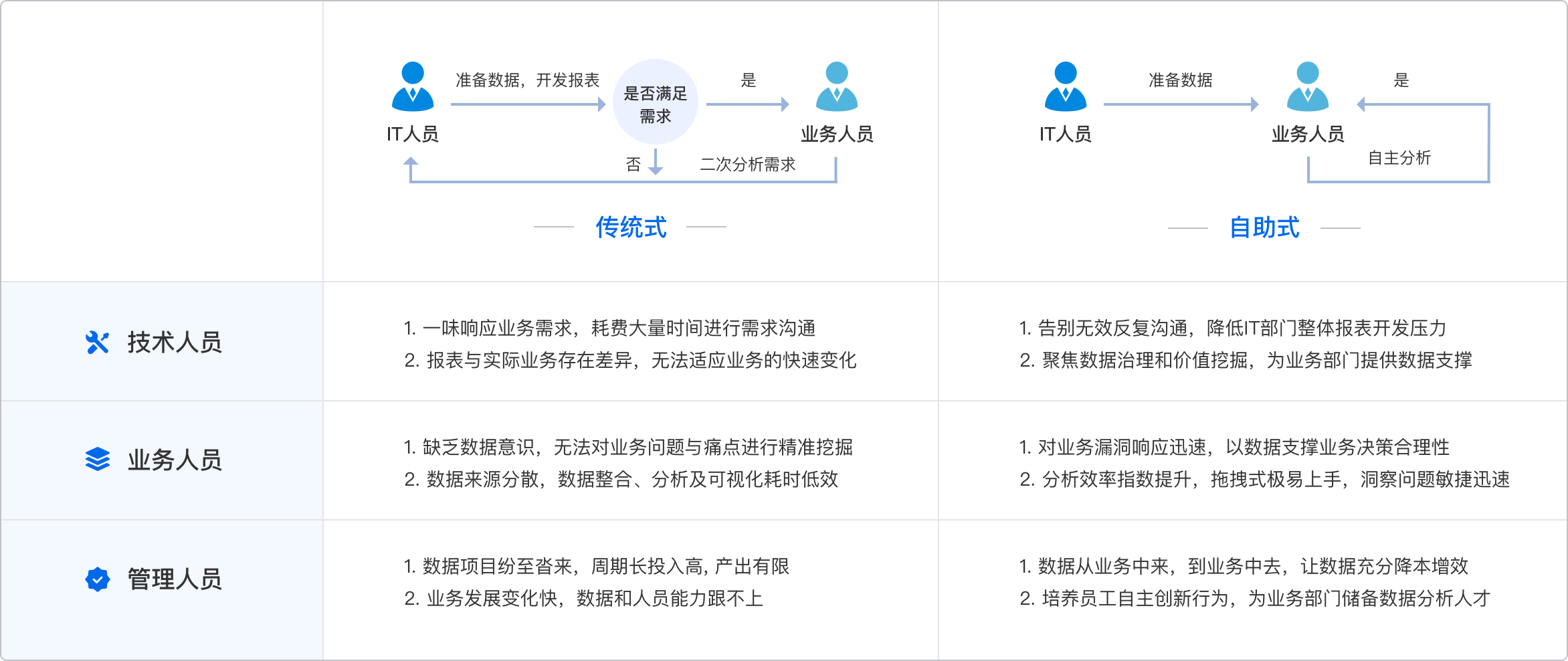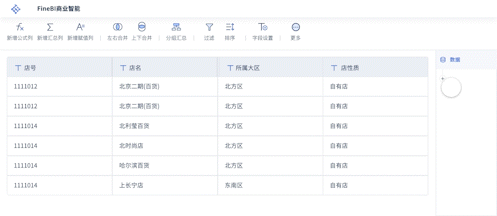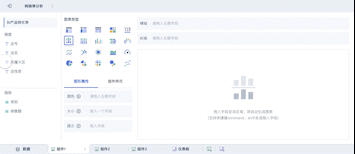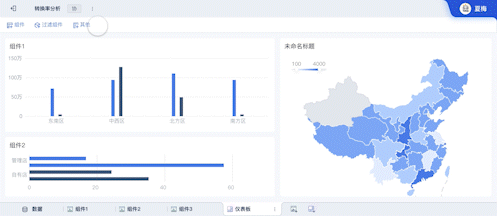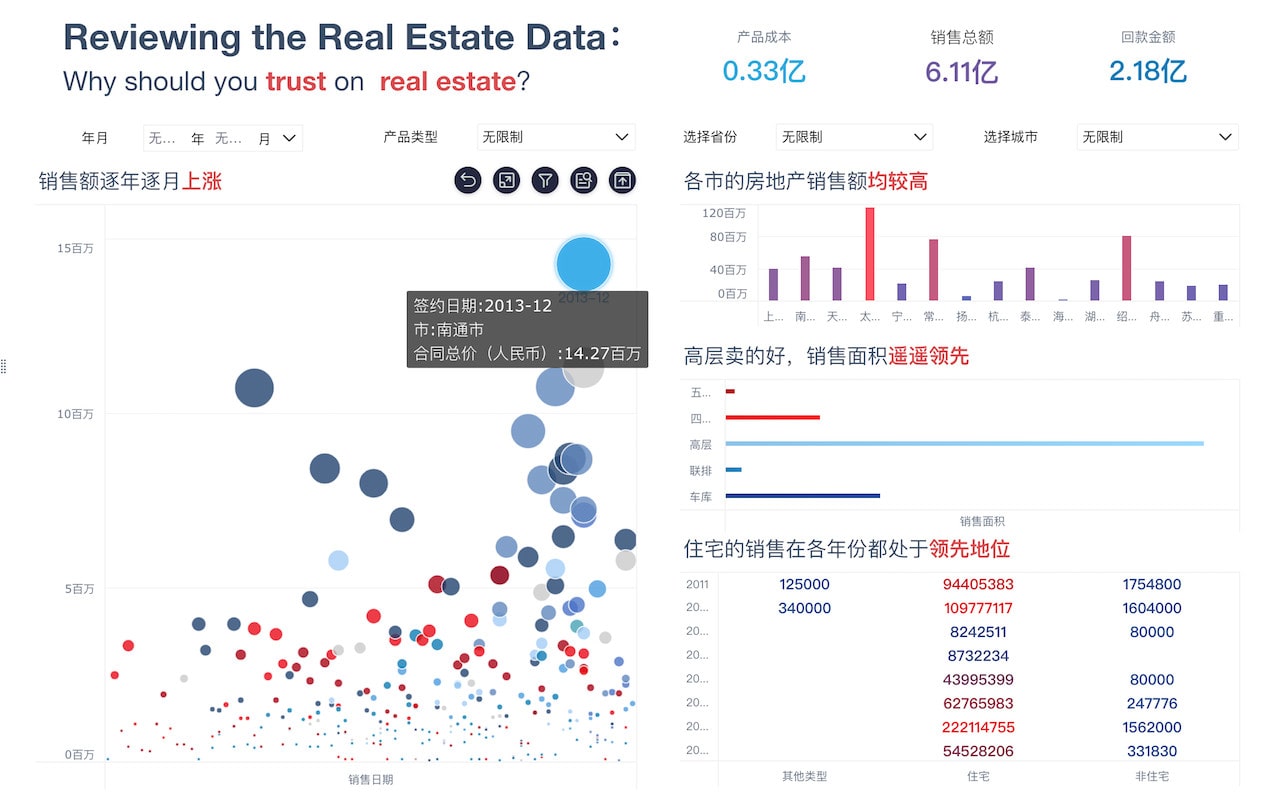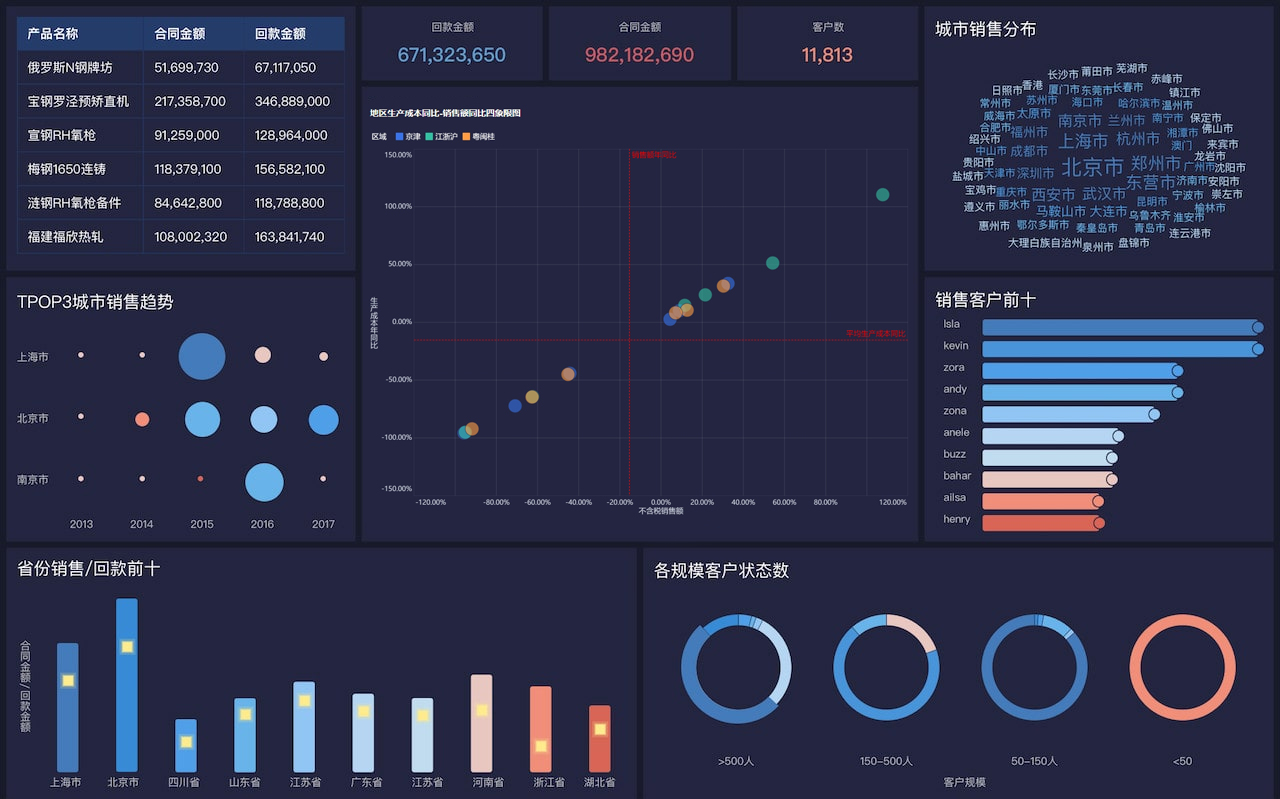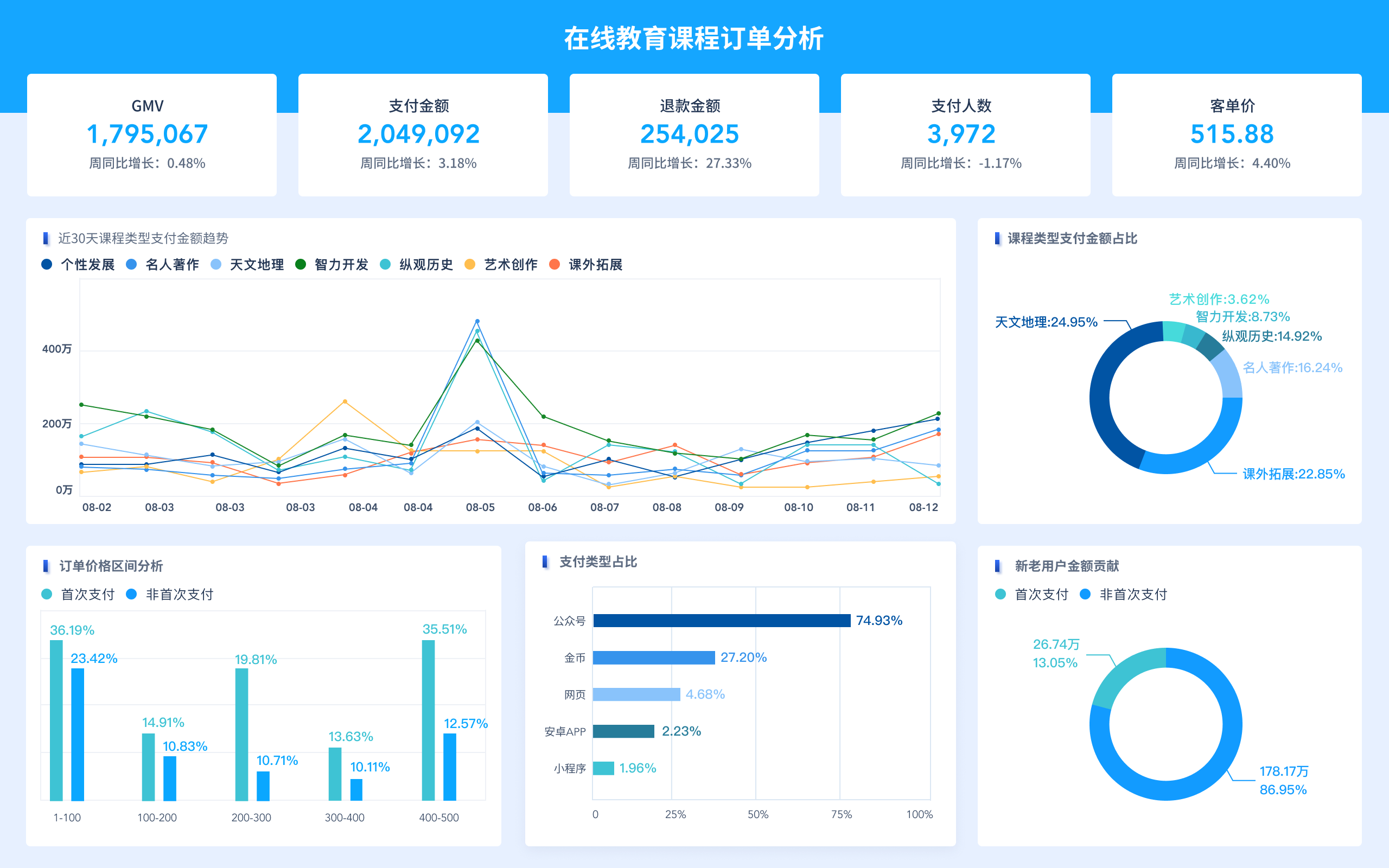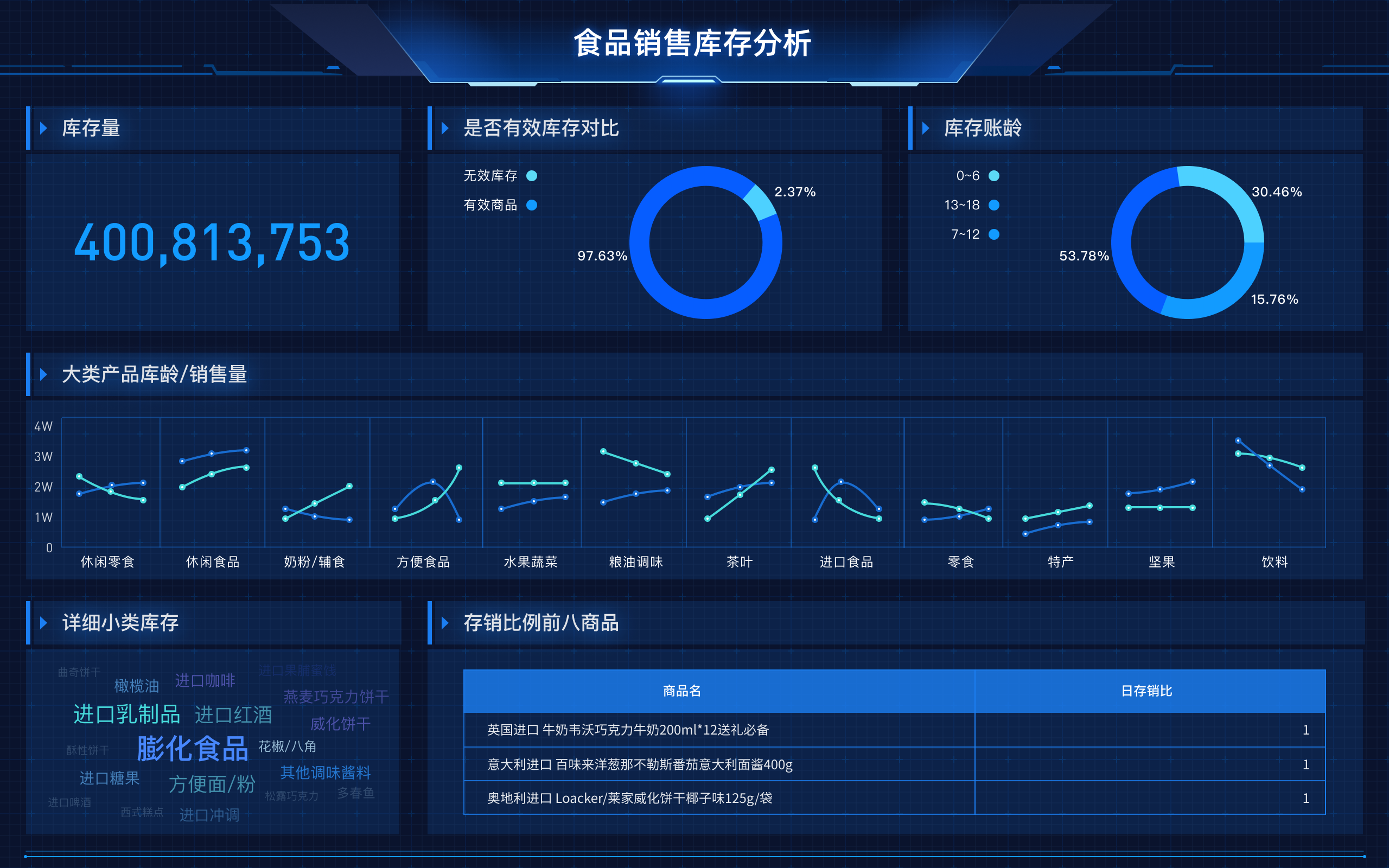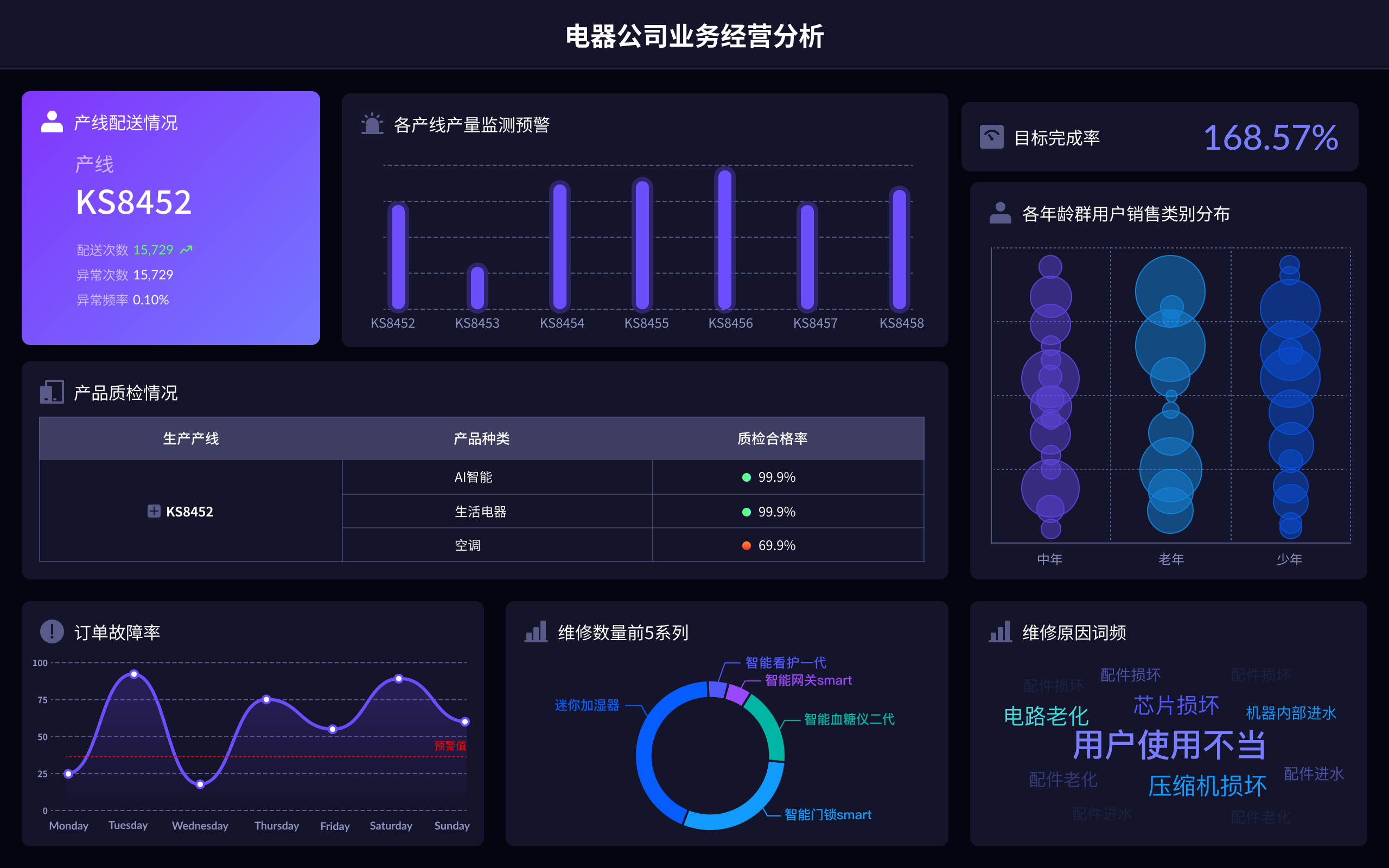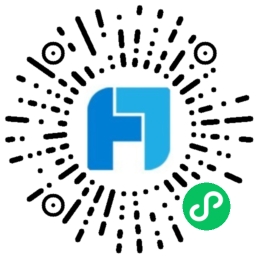
The term "可视化大屏" in English is "visualization large screen" or more commonly "data visualization dashboard". These terms highlight its function of displaying data in a visual format on a large screen for easy understanding and analysis. Data visualization dashboard is more frequently used because it captures the essence of presenting various data sets interactively on a large screen for comprehensive data insights.
I、DATA VISUALIZATION DASHBOARD DEFINITION
A data visualization dashboard is an information management tool that visually tracks, analyzes, and displays key performance indicators (KPIs), metrics, and data points. Dashboards provide a centralized, interactive way to monitor various data sources, enabling real-time decision-making. Key features include real-time data updates, interactive elements like charts and graphs, and the ability to pull data from multiple sources.
II、IMPORTANCE OF DATA VISUALIZATION DASHBOARDS
Data visualization dashboards are crucial for several reasons. They simplify complex data, enable quick decision-making, and provide real-time insights. By displaying data visually, dashboards help users quickly understand trends, patterns, and outliers. This is particularly valuable for businesses that need to make data-driven decisions rapidly.
- Simplification of Complex Data: Data visualization dashboards transform complex data sets into easily understandable visuals. Charts, graphs, and maps enable users to grasp intricate data insights quickly.
- Real-Time Insights: Dashboards provide up-to-date data, allowing for timely decisions. Real-time monitoring is essential for tracking business performance and responding to changes promptly.
- Enhanced Decision-Making: Visual data aids in faster and more informed decision-making. Managers and executives can use dashboards to identify issues, monitor progress, and adjust strategies accordingly.
III、COMPONENTS OF A DATA VISUALIZATION DASHBOARD
A well-designed data visualization dashboard consists of several key components:
- Widgets and Visual Elements: These include charts, graphs, tables, and maps. Each widget should be chosen based on the type of data being represented and the insights needed.
- Data Sources Integration: Effective dashboards pull data from various sources such as databases, APIs, and spreadsheets. Integration capabilities ensure that all relevant data is considered.
- Interactive Features: Filters, drill-downs, and hover-over details enhance user interaction. Interactivity allows users to explore data deeper and gain specific insights.
- Customizability: Dashboards should be customizable to meet different user needs. Users should be able to adjust the layout, select which data to display, and tailor the visualizations to their preferences.
- User-Friendly Interface: An intuitive and easy-to-navigate interface is essential. A user-friendly design ensures that users can efficiently access and interpret the data presented.
IV、BEST PRACTICES FOR DESIGNING DATA VISUALIZATION DASHBOARDS
Designing an effective data visualization dashboard requires following best practices:
- Know Your Audience: Understand the needs and preferences of your audience. Different users may require different types of data and visualizations.
- Keep It Simple: Avoid clutter and keep the design clean. Focus on the most critical data points to avoid overwhelming users.
- Use Appropriate Visuals: Select the right type of visualization for your data. Bar charts, line charts, pie charts, and maps each serve different purposes and are best for different data types.
- Ensure Data Accuracy: Verify that the data being displayed is accurate and up-to-date. Inaccurate data can lead to incorrect decisions.
- Provide Context: Include labels, legends, and tooltips to provide context. Users should easily understand what the data represents and the significance of the trends shown.
- Design for Scalability: Ensure the dashboard can handle an increasing amount of data and users. Scalability is important for long-term usability and effectiveness.
V、TOOLS FOR CREATING DATA VISUALIZATION DASHBOARDS
Several tools are available for creating data visualization dashboards:
- FineReport: A professional tool that provides comprehensive reporting and data visualization capabilities. It allows for seamless integration with multiple data sources and offers interactive dashboard features. More details can be found on the FineReport official website.
- FineVis: This tool focuses on creating sophisticated visualizations and is part of the same suite as FineReport. It’s designed to offer advanced visualization options for complex data analysis. Learn more at the FineVis official website.
- Tableau: A widely-used platform known for its powerful data visualization capabilities. It provides extensive options for creating interactive and shareable dashboards.
- Power BI: Microsoft's business analytics tool, offering robust visualization and reporting features. It integrates well with other Microsoft services and provides real-time data updates.
- QlikView: Known for its associative data model, QlikView allows users to explore data freely. It offers a highly interactive and customizable dashboard environment.
- Google Data Studio: A free tool that integrates well with other Google services. It is user-friendly and ideal for creating basic to intermediate level dashboards.
VI、CASE STUDIES AND EXAMPLES
Examining real-world examples can provide insights into effective dashboard design and use:
- Healthcare Dashboards: Used to monitor patient data, track hospital performance, and manage resources. These dashboards help improve patient outcomes and operational efficiency.
- Financial Dashboards: Employed by financial institutions to track market trends, portfolio performance, and risk management. They provide real-time insights crucial for investment decisions.
- Sales and Marketing Dashboards: Utilized to monitor sales performance, track marketing campaigns, and analyze customer data. These dashboards aid in optimizing sales strategies and improving customer engagement.
- Manufacturing Dashboards: Used to track production metrics, monitor supply chain status, and ensure quality control. They help in maintaining operational efficiency and reducing downtime.
VII、FUTURE TRENDS IN DATA VISUALIZATION DASHBOARDS
The future of data visualization dashboards looks promising with several emerging trends:
- Artificial Intelligence Integration: AI can enhance data analysis by identifying patterns and providing predictive insights. AI-driven dashboards will offer more accurate and actionable insights.
- Augmented Analytics: This combines AI and machine learning to automate data preparation and insight generation. Users can expect more intuitive and powerful dashboards.
- Mobile Accessibility: Increasing demand for mobile-friendly dashboards. Future dashboards will be designed to work seamlessly on mobile devices, ensuring data is always accessible.
- Enhanced Interactivity: More interactive features will allow deeper data exploration. Users will be able to manipulate data visualizations to uncover specific insights.
- Real-Time Collaboration: Dashboards will support real-time collaboration, enabling teams to work together on data analysis. This feature will improve decision-making and operational efficiency.
- Data Storytelling: Combining data visualization with storytelling techniques to convey insights more effectively. Dashboards will not only present data but also narrate the data story to enhance understanding.
In conclusion, data visualization dashboards are an indispensable tool for modern data analysis and decision-making. By leveraging the right tools and best practices, organizations can create impactful dashboards that drive business success.
相关问答FAQs:
可视化大屏英文叫什么?
可视化大屏在英文中通常被称为 "Visualization Dashboard" 或 "Visual Display Screen"。这种设备或软件应用程序旨在通过图形、图表和其他可视化元素,帮助用户更直观地理解数据和信息。可视化大屏常用于商业智能、数据分析、监控系统等领域,能够将复杂的数据转化为易于理解的信息,帮助企业决策者快速做出反应。
可视化大屏的主要功能是什么?
可视化大屏的功能多种多样,主要包括数据展示、实时监控、趋势分析、交互式数据探索等。通过集成不同的数据源,用户可以在一个统一的界面上查看到关键指标和趋势。实时监控功能允许企业随时获取最新数据,以便快速识别潜在问题或机会。趋势分析则通过可视化的方式,帮助用户识别数据中的模式和变化,从而支持更有效的决策过程。此外,许多可视化大屏还提供交互功能,用户可以通过点击或拖动等操作深入探索数据,获取更详细的信息。
如何选择合适的可视化大屏软件?
选择合适的可视化大屏软件需要考虑多个因素,包括用户需求、数据源兼容性、可视化能力、用户界面友好性以及预算等。首先,明确使用该软件的目的,例如是用于业务分析、市场监控还是项目管理。其次,确保所选软件能够与现有的数据源无缝集成,支持多种数据格式和数据库。可视化能力也是关键,软件应提供丰富的图表类型和自定义选项,以满足不同的展示需求。此外,用户界面应简洁直观,方便用户快速上手。最后,根据预算选择合适的解决方案,有些软件提供免费试用,建议在购买前先进行评估。
本文内容通过AI工具匹配关键字智能整合而成,仅供参考,帆软不对内容的真实、准确或完整作任何形式的承诺。具体产品功能请以帆软官方帮助文档为准,或联系您的对接销售进行咨询。如有其他问题,您可以通过联系blog@fanruan.com进行反馈,帆软收到您的反馈后将及时答复和处理。


